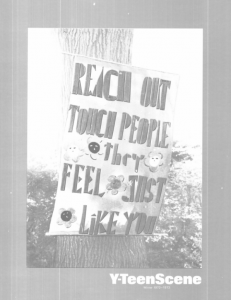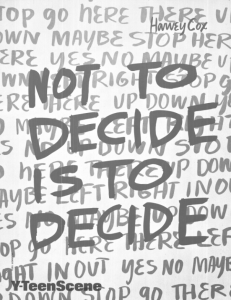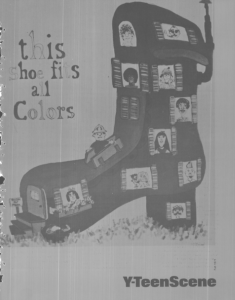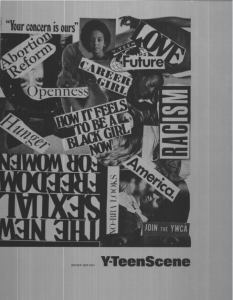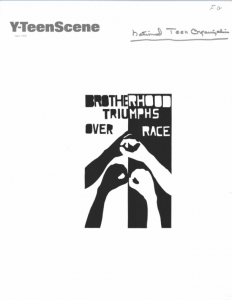 Now that summer is here, and kids and teens have time outside of school to play, and create and interact with their communities it seems like a great time to celebrate how awesome kids and teens are, and what an integral role they play in building communities, and building movements. The YWCA has always worked on behalf of young people, specifically young women, and valued the contributions of these young women to the development of their mission. A great example of that commitment and the interaction of teenage women with that commitment is the YWCA publication Y-Teen Scene, which documented the lives and work of teenage girls who were active within the YWCA, and published content produced by teenagers with the intent of promoting teen empowerment and civic engagement.
Now that summer is here, and kids and teens have time outside of school to play, and create and interact with their communities it seems like a great time to celebrate how awesome kids and teens are, and what an integral role they play in building communities, and building movements. The YWCA has always worked on behalf of young people, specifically young women, and valued the contributions of these young women to the development of their mission. A great example of that commitment and the interaction of teenage women with that commitment is the YWCA publication Y-Teen Scene, which documented the lives and work of teenage girls who were active within the YWCA, and published content produced by teenagers with the intent of promoting teen empowerment and civic engagement.
Y-Teen Scene was published by the national office of the YWCA from 1968-1973 as a continuation of the previous publication titled The Bookshelf. Y-Teen Scene was published for a short run of five years until the YWCA national board decided it wasn’t cost-effective to continue publishing. The change from The Bookshelf to Y-Teen Scene was described in the first issue of the latter publication as “a new name and new dress,” for the former publication. This change arose from demand by youth organizations and Y-teens themselves, and an eventuated commitment from the national board to putting Y-teens in positions of leadership and authority in teen-centered spaces. These magazines are interesting and inspiring because they are a very clear example of the YWCA’s commitment to empowering young women and girls, to validating their experiences and feelings, as well as respecting and utilizing their capacity to enact change in their communities.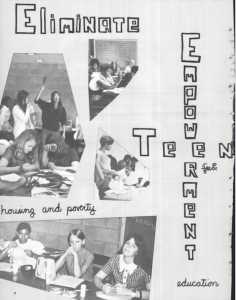
There are recurring segments in the magazine that were intended to highlight youth and teen community activism and involvement. The segments “Youth Involvement” and “Teen Empowerment” document the administrative involvement of teens in the YWCA– like which teens were elected to different officer positions or who spearheaded different projects and causes that worked on behalf of teens and their communities. Another segment “Hey Youz” features visual art and poetry produced by teens that reflect values, anxieties, cultures and moments in their lives. The segment describes itself as a space “reserved for teens’ poems, photos, original ideas, thoughts, suggestions,” and requests that teen readers send in their own contributions. These recurring segments are paired with longer, more in-depth articles that highlight community interventions and events that teens are involved with as they address the issues that affect their diverse lives and communities.
As Y-teens became more involved in producing and selecting the content included in Y-Teen Scene, the content itself and style with which it was presented changed to reflect more directly the issues and perspectives embodied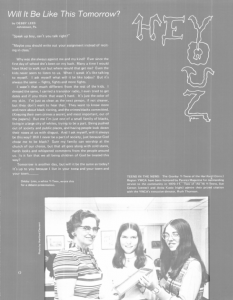 and experienced by Y-teens. One clear focal shift was around racial justice. The YWCA’s national office took up the mantle of achieving and promoting racial justice in the United States at the 1970 National Convention in Houston, Texas. At this convention, the YWCA officially adopted one imperative,
and experienced by Y-teens. One clear focal shift was around racial justice. The YWCA’s national office took up the mantle of achieving and promoting racial justice in the United States at the 1970 National Convention in Houston, Texas. At this convention, the YWCA officially adopted one imperative, 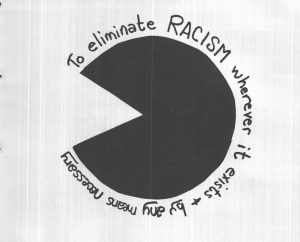 “To trust our collective power towards the elimination of racism, wherever it exists, by any means necessary.”
“To trust our collective power towards the elimination of racism, wherever it exists, by any means necessary.”
In the years leading up to the adoption of this one imperative Y-Teen Scene’s content began explicitly tackling issues dealing with racial marginalization and discrimination in the United States, and in the communities that Y-teens lived and worked in. This change in content and focus is evident in a number of ways throughout the publications, specifically in the subject of the covers, the style and content of the artistic pieces it featured, as well as the teens and teen-centered events that it reported on.
Art that was featured on the cover of Y-Teen Scene, which was often produced by teenagers themselves or utilized by them in their activist work, had slogans and phrases like “Brotherhood Triumphs Over Race,” “Reach out, touch people. They feel just like you,” and “Not to Decide is to Decide.” The art and imagery similarly incorporated empowering words and images and invoked empowering concepts. The covers also frequently depict images of hands in different skin tones touching each other, reaching in the same direction, or holding up the same image. One cover, which is pictured below, riffs of the nursery rhyme of the little old woman who lives in a shoe and depicts a large boot with windows, and has the small faces of people of many different races and ethnicities, as is accompanied by the words, “This Shoe Fits All Colors.”
The intention of these covers and art pieces clearly was to communicate that racial justice and equality is the mission of the publication and the YWCA and that this mission was being prioritized in a way it hadn’t been in the past. The communication of this message was also distinctly youthful in style. Twice the covers depicted collages of newspaper and magazine headlines and images of YWCA members. This utilized a technique frequently associated with teenagers and teenage art and was occasionally featured in other parts of the magazine, as featured art or as decorative headings.
Y-Teen Scene was a publication that responded to teens and centered the issues that they cared about most. It did this work in a way that put teen effort and teen activism front and center, and that prioritized the adoption of the One Imperative of Racial Justice explicitly. This publication reported on the events and issues that teens participated in and cared about, but it also celebrated teen life and energy in a way that validated their importance in the community building and movement building efforts that the YWCA hoped to achieve.
The information in this blog post, and any art piece or cover subject was pulled from the pages of the serial publication Y-Teen Scene, all copies of which can be found in the YWCA of the U.S.A. records, housed in the Sophia Smith Archive at Smith College in Northampton Massachusetts. Additionally, all of these publications have all been digitized in our YWCA digitization project and will be available digitally. This digitization project intends to diversify access to publications like Y-Teen Scene that have recorded the important activist work of teens and members of the YWCA at an important and transitional time in the YWCA’s history, and in the development of its mission.
Teens are powerful! Grab a teen and check out Y-Teen Scene today!
By Gracie Elliott, Student Assistant

